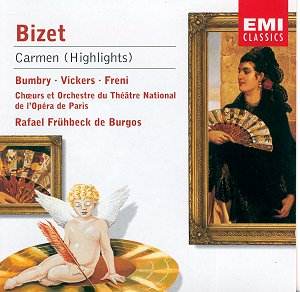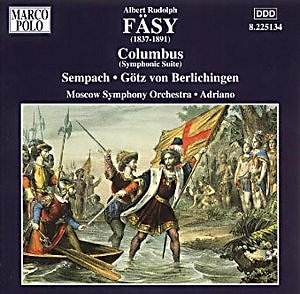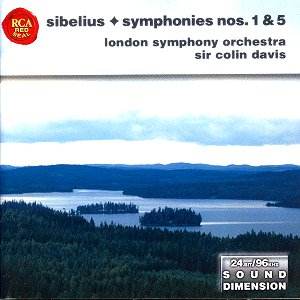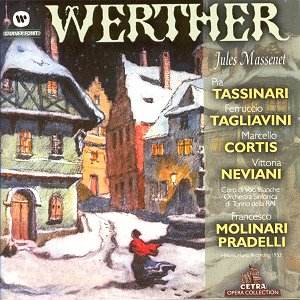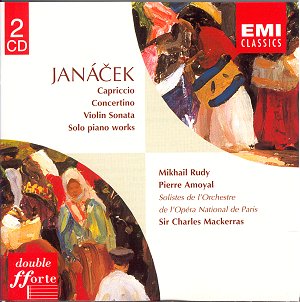 Composer: Leos Janacek
Composer: Leos Janacek
Works: Pohadka, Presto in E minor, Violin Sonata, Capriccio, Concertino, From the Street 1 X 1905, In the mists, Reminiscence, On the overgrown path, Three Moravian Dances
Performers: Mikhail Rudy, piano; Gary Hoffman, cello; Pierre Amoyal, violin; Soloists from l’Orchestre de l’Opera National de Paris, conducted by Sir Charles Mackerras
Recording: Salle Ravel, Opera-Bastille, June 1995 (Pohadka, Presto, Violin Sonata, Capriccio, Concertino) and Eglise du Liban, Paris, March 1990 (From the Street, In the mists, Reminiscence, On the overgrown path, Three Moravian Dances)
Label: EMI
Leos Janacek, a titan of early 20th-century music, synthesized the complexities of his Czech heritage and the modernist tendencies of his time to create works that are as emotionally charged as they are technically innovative. This double-disc set, featuring the interpretations of Mikhail Rudy and a host of distinguished performers under the baton of Sir Charles Mackerras, offers a compelling survey of Janacek’s diverse output, ranging from vibrant chamber works to his introspective piano pieces. Each piece is imbued with the composer’s characteristic blend of folk influences and avant-garde sensibilities, providing a rich tapestry for analysis and appreciation.
Mikhail Rudy emerges as a formidable interpreter of Janacek, demonstrating a profound understanding of the composer’s nuanced emotional landscape. His performance of the Piano Sonata is particularly noteworthy; the contrasting approaches between Rudy and the renowned Rudolf Firkusny—whose interpretations have long been considered definitive—serve as a fascinating point of inquiry. Rudy’s execution is marked by an internalized lyricism, a quality that allows him to navigate the jagged rhythms and sudden dynamic shifts with remarkable fluency. In the “From the Street” movement, for instance, the way Rudy engages with the stark contrasts in mood—the turbulent, agitated passages juxtaposed with moments of wistful reflection—illustrates a deep interpretative insight that resonates with the listener.
The instrumental interplay in the chamber works is equally captivating, with Gary Hoffman on cello and Pierre Amoyal on violin providing a robust dialogue that complements Rudy’s piano. The “Concertino” is a case in point, where the ensemble’s cohesion allows for a seamless blend of textures. Mackerras’s conducting is vital in this context; his ability to draw out the dramatic flexibility inherent in Janacek’s syntax provides an atmosphere where the musicians can explore the emotional depths of the score. The recording captures these nuances beautifully, with a clarity that allows each instrumental voice to shine through while maintaining the integrity of the ensemble sound.
The engineering quality of this recording merits commendation as well. The acoustics of Salle Ravel and the Eglise du Liban offer a vibrant resonance that enhances the textures of Janacek’s orchestration. The spatial balance between the piano and the strings is particularly well-handled, allowing for the intricate counterpoint to emerge without overshadowing the lyrical lines. This attention to detail is crucial, especially in works like “On the overgrown path,” where the subtleties of dynamics and phrasing can significantly alter the emotional impact.
Rudy’s performances, while distinct from those of Firkusny, stand on their own merits. His interpretative choices—marked by a more pliant approach compared to Firkusny’s sharper edges—highlight a different facet of Janacek’s musical language. The recording presents a comprehensive view of the composer’s oeuvre, unveiling the emotional and technical complexities that have made Janacek a perennial subject of study and admiration.
This collection is not merely an assemblage of Janacek’s works; it is a testament to the enduring relevance of his music through vivid interpretations and exemplary collaboration. Mikhail Rudy, alongside his colleagues and the superb guidance of Sir Charles Mackerras, crafts a compelling narrative that invites listeners to engage with Janacek’s music on multiple levels. The disc is unequivocally recommended for both newcomers to Janacek and seasoned aficionados alike, as it captures the essence of a composer whose voice continues to resonate powerfully in the concert hall.
